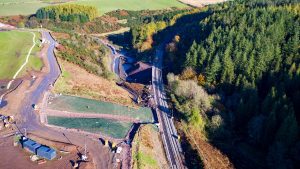 The Aberdeen-Dundee railway line will be opened tomorrow after the completion of work to repair the line following August’s tragic derailment.
The Aberdeen-Dundee railway line will be opened tomorrow after the completion of work to repair the line following August’s tragic derailment.
The railway has been shut since August 12, when the 06:38 ScotRail Aberdeen-Glasgow service struck a landslip with the devastating loss of the driver, conductor and a passenger.
The incident caused extensive damage to the track, bridge, embankments and drainage systems at the accident site at Carmont, near Stonehaven.
Network Rail’s engineers have been working around-the-clock since the incident, initially supporting the accident investigation before beginning work in September to recover the derailed train carriages and repair and reopen the railway.
To restore the traffic on the Aberdeen-Dundee railway, the works included the replacement of over 500 metres of damaged track, 70 metres of bridge parapets and relaying 400 metres of telecoms cables, the reconstruction of the railway embankment beneath the accident site and the repair and enhance of the drainage systems and flood defences above and below the line.
In addition, Network Rail has constructed a 900-metre road and temporary bridges over the surrounding farmland to bring specialist lifting equipment to the site, a 600-tonne crawler crane to carefully lift the derailed carriages from the railway.
ScotRail has been operating a shuttle service between Aberdeen and Stonehaven and between Montrose and Edinburgh to keep customers in the north east moving. Replacement bus services have also been in place between Aberdeen and Edinburgh, linking into cross-border trains.
“We continue to work closely with accident investigators as we seek to learn the lessons of this tragedy and make our railway as safe as possible for our people and our passengers,” Alex Hynes, managing director of Scotland’s Railway, said.
After the incident, Network Rail introduced a range of additional safety measures. As an immediate precaution, hundreds of sites nationwide with higher-risk trackside slopes, similar to Stonehaven, were inspected. These inspections were carried out by both in-house engineers and specialist contractors, supplemented by helicopter surveys.
The British rail infrastructure manager has also launched two taskforces, led by independent experts, as part of its long-term response to climate change and the challenge of maintaining its massive portfolio of earthworks – embankments and cuttings, many of which date from the Victorian era. Network Rail already invests heavily in earthworks and drainage, and spending has increased significantly in recent years from £550 million (EUR 610.4 million) between 2009 and 2014 to a budget of £1.3 billion (EUR 1.44 billion) for the period between 2019 and 2024.
Share on:



